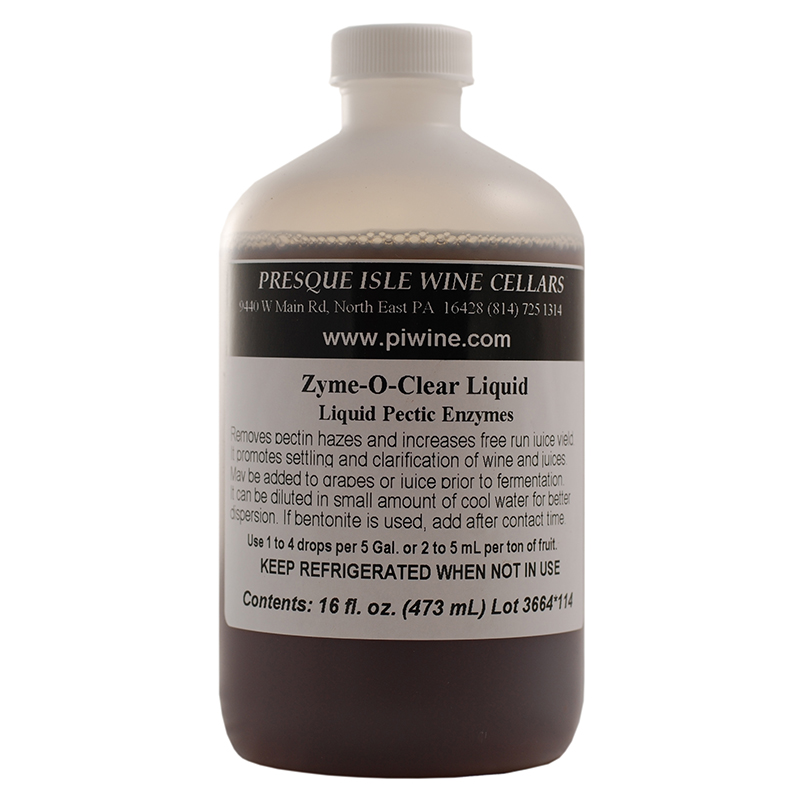Use of Pectic Enzymes in Winemaking
Use of Pectic Enzymes in Winemaking
Enzymes are proteins which are produced by living organisms and which act as biological catalysts. All living organisms produce enzymes which produce very specific chemical reactions which are necessary to the survival of the organism.
The most common descriptive terms for enzymes are derived from the substrate which they affect and typically have the suffix “-ase” added. For example, the enzymes which attack proteins are called “proteases” and the enzymes which attack pectins are called “pectinases”.
Classes of Enzymes
Among the many classes of enzyme reactions the following are most important in processing wines and fruit juices:
Amylases break down starch (which derives from the Greek amylon) into dextrins.
Glucoamylases degrade dextrin to glucose. Proteases degrade proteins which prevents protein hazes in beer and wine.
Pectinases break down pectins which prevents pectin hazes, gives improved yield of juice when pressing, produces faster settling of juice, and in some cases may also release more aromatic constituents and increase the extraction of color components. These are the enzymes most useful to the winemaking process.
Cellulases break down cellulose and thus aid in juice extraction. Invertases split sucrose into its component fractions of fructose and glucose.
Enzymes for Commercial Winemaking
Most enzymes are produced by industrial bacterial fermentations. In the US the organism most commonly utilized is Aspergillus niger. TTB has only approved enzymes produced by that bacterium for use by commercial wineries.
In earlier times the producers observed mutations which improved the efficiency or purity of the resulting enzymes and would isolate and reproduce those organisms that produced them. In recent years it has been possible to manipulate some of these mutations and develop strains capable of producing more quickly and at higher concentrations.
Commercial enzymes began to be used in wines around 1960. At that time enzymes of 5 or 10 fold strength were at the leading edge. Today there are enzymes of 15,000 or higher ADJU’s, a common means of describing the strength of the enzyme, which stood for the term “Apple Juice Depectinization Units”.
Types and Functions of Pectic Enzymes
Pectic Enzymes are the most beneficial and most commonly used enzyme class for winemaking. Currently available pectic enzymes may have fairly specific functions, but alternatively, may be formulated to perform multiple functions. They are often mixtures which stress a particular function, but which will do others as well.
Clarifying Enzymes
Clarity is the most common reason for using pectic enzymes. Clarifying Enzymes produce faster settling and more compact lees and permit a shorter time before starting fermentations. Grapes which have infections of Botrytis cinerea tend to be difficult to settle and, because of the gummy nature of the juice, don’t settle as fast and tend to ‘blind’ the filter media more quickly. There are some enzymes produced in Europe which are very good at eliminating these difficulties, but they haven’t been available to commercial wineries in the USA because they weren’t produced from Aspergillus niger. There are ongoing efforts to get them approved here. Even so, there are some newer enzymes which are at least better than what we have had until recently.
Macerating Enzymes
These enzymes typically perform the clearing functions done by other enzymes, but they are also rich in enzymes which more efficiently extract the color potential of a given batch of juice or wine. They are effective only during the period of skin contact. Some of these enzymes actually extract more color intensity while others promote stability of color so that you don’t lose as much over time. Certain tannins are also very important in promoting color stability.
Having a warmer fermentation (80° to 90° F during the first two or three days of fermentation, for instance) will give you better color extraction. However you don’t want to keep the wine at that temperature much longer because of the risk of a ‘stuck’ fermentation.
Another way is to follow the practice that Philip Wagner followed at Boordy Vineyards, in Maryland. He would draw off some of the juice or wine after about 24 hours to use for his rosé wines. He in effect had a higher ratio of skins to liquid.
Aromatic Enzymes
Aromatic Enzymes release the aromatic potential of monoterpenes which are often bound up in forms that inhibit aroma expression. They are not very effective except in grape varieties with higher levels of the monoterpenes such as Riesling, Sauvignon Blanc, Gewurztraminer, Chenin Blanc and Viognier. It is generally best to add Bentonite after a month or so following treatment with one of these enzymes, to inactivate them in order to prevent some less pleasant aroma components that might develop over time.
Lysozymes
These enzymes will degrade the poly-saccharides found in the cell walls of gram positive bacteria such as Oenococcus, Pediococcus and Lactobacillus. They can often inhibit a later malo-lactic in whites completely, but usually only delay one in reds. If used early in the fermentation with unsound grapes, they can help prevent the growth of organisms which would slow or inhibit the sugar fermentation.
Useful Effects of Enzymes in Winemaking
A list of the effects produced in wines or juices by enzymes includes the following:
- Free run juice during pressing may be as much as 10% higher and average yields are almost always higher.
- Color of the resulting wine is usually higher in whites when the enzyme is added to the crushed grapes, but not in all cases. You may wish to add the enzymes to the separated juice if color is an issue.
- Color is almost always better with reds, especially when using a “macerating” type of enzyme.
- Maturity is usually faster with enzyme treated wines. Sometimes such wines decline faster than untreated wines. This potential problem may be vitiated by treatment with bentonite, which tends to inactivate the enzymes.
- Enzyme treated wines tend to filter better.
- Enzyme treated wines and musts tend to have fewer problems with foaming. I find that foaming relates more to the particulate matter in the wine than to the speed of fermentation.
- Enzyme activity will increase with levels of use or with increases in temperature. A rule of thumb is that you double the activity with every 10° F increase in temperature (at least up to the point where the enzymes are inactivated in the 120° F to 130° F range) and doubling of the amount of enzymes used.
- At the lower end of the temperature range you need more time to get clarity and get little help when you are below 30° F. American Tartaric claims that the powdered forms may be slightly faster at temperatures, because the liquids may gel a bit when added to cold liquids; however they think that the difference may not be significant.
- We have been unable to find any relevant research on whether you should avoid using enzymes when you have very greenish tannins. We have some concern about extracting more green tannins, but don’t have enough evidence to be sure of the effects.
- Most enzymes will work over the range of pH2.5 to pH5.5 and are not inhibited by sulfur dioxide levels normally found in wines.
Enzymes should be stored at refrigerator temperatures (30° to 40° F) at which temperature liquid enzymes will lose 3 to 5% of their viability per year. At ambient temperatures they lose 20 to 30% viability per year.
Powders have more stability, losing only 1% to 2% per year, although many people can have respiratory issues with the powdered forms.
RETURN TO WINEMAKING 101 SHOP ALL ENZYMES

